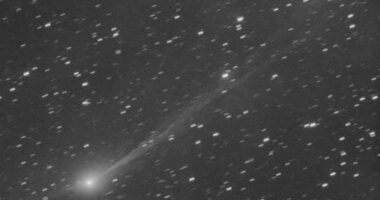Share this @internewscast.com
Whether it’s from a classroom globe or one of NASA’s stunning satellite images, most people are pretty familiar with how our planet looks.
But a rarely seen angle of Earth is now freaking people out.
In a viral post on X, which has been seen more than 33 million times, a user shares a picture of ‘the side of planet Earth we aren’t used to seeing’.
This strange view of a planet seemingly devoid of any land has sent social media into a frenzy, with one commenter writing: ‘This is scary’.
Most of us are used to seeing Earth from the Northern Hemisphere because this half of the globe is home to 68 per cent of the planet’s land.
However, although it is a well-known fact, it is easy to forget that over 70 per cent of the Earth’s surface is covered by water.
In what’s referred to as the ‘oceanic hemisphere’, the hemisphere of Earth predominantly covered by water, oceans cover 89 percent of the surface while a mere 11 percent consists of land.
Presented with a baffling view of this side of the ‘blue planet’, one commenter joked: ‘Earth should actually be called water.’

A viral post on X, the platform formerly known as Twitter, features an image of ‘the side of planet Earth we’re unfamiliar with seeing’, causing a stir among viewers.

The picture shows Earth’s ‘oceanic hemisphere’, the side of the planet with the most water, where oceans cover 89 per cent of the surface

On social media, people have been freaked out by this unusual perspective, with one commenter dubbing it the ‘scary side’

Another commenter joked that with 71 per cent of the planet covered by oceans, Earth should really be called ‘water’
This viral image shows the vast expanse of the Pacific Ocean, the largest ocean on the planet.
The Pacific Ocean spans an astonishing 63 million square miles and holds more than half of the planet’s ‘free’ water, which is the water not contained within mineral structures in rocks.
This ocean is so staggeringly large that all of the continents could comfortably fit inside the Pacific Ocean basin.
In the image, you can just make out the green of New Zealand in the lower left while part of Antarctica is peeking out over the corner of the globe in the lower right.
In the top right-hand corner, you can also just make out the west coast of North America.
However, there is a little more land on this side of the planet than the image makes out, but these islands are so small as to be difficult to see
This side of the planet also contains the Hawaiian Islands, Fiji, Tonga, Samoa, as well as many other Polynesian, Melanesian, and Micronesian island nations such as French Polynesia and the Phoenix Islands.
The oceanic hemisphere captured in this incredible image is also the location of Point Nemo, the most remote location on Earth.

We are used to seeing the ‘blue marble’ view of Earth, which mainly shows the Northern Hemisphere, where 68 per cent of the planet’s land is located

At Point Nemo, the most remote point captured in this image, you would be so far from land that the closest humans would be on the International Space Station

A commenter joked that this was like seeing the ‘back of Earth’s head’

One social media user mused that aliens might think Earth was lifeless if they saw this side of the planet

One commenter complained that the Pacific Ocean is ‘too damn big’
In the centre of the Pacific Ocean, Point Nemo is so far from any land that the nearest humans are on the International Space Station 254 miles (408km) above.
Seeing this vast expanse of water has left some social media users feeling quite uncomfortable.
One commenter wrote: ‘The Pacific Ocean is too damn big!’
Another chimed in: ‘You ever realize how much of our planet is actually… water? Now you do. 165 million km² of deep, humbling silence.’
‘Could be some aliens out there looking and seeing this thinking “well, no life there worth checking out, it is just another waterworld”,’ one commenter mused.
With another adding jokingly: ‘The back of Earth’s head is crazy’.
But not everyone was so upset by this image, and many seemed to find it quite appealing.
‘Drop me off there,’ a commenter wrote.

The view of the planet sparked a reflective mood in some commenters, with one contemplating the ocean’s ‘165 million km² of deep, humbling silence’

Other users seemed attracted to this quiet side of the Earth, with one asking to be dropped off there

A social media user dubbed the oceanic hemisphere as the ‘most peaceful part of the planet’
One social media user wrote: ‘Makes me wonder what mysteries are hiding beneath all that water!
While another added: ‘Looks peaceful.’
One social media user even dubbed this the ‘most peaceful part of the planet.’
Meanwhile, some less geographically aware social media users were simply baffled by what they were seeing.
One commenter asked, ‘WHERE IS THIS?’ while another wanted to know: ‘Is this Antarctica?’
And for some internet-dwelling conspiracy theorists, seeing the other side of the planet was simply too much to handle.
One conspiracy theorist wildly claimed: ‘This is the bottom of the flat Earth. This picture is made from beneath and the flat surface is spherical, and that is where there is confusion that the Earth is flat or spherical.
Another confused commenter wrote: ‘How is there not an oval or flat earth if all the land seems to be on one side?!’

The ocean in the image isn’t as devoid of land as the photo would suggest. There are many small islands not visible, such as the Phoenix Islands (pictured)

For some internet-dwelling conspiracy theorists, seeing the other side of the planet was simply too much to handle

Conspiracy theorists couldn’t seem to understand how seeing another side of the Earth was possible

One commenter questioned whether the image was ‘fake’ and wondered if the Earth might not be ’round at all’
While another suggested: ‘Looks very fake to me. Maybe the earth is not round at all.’
However, as for Kiwi commenters, many were just happy to see New Zealand firmly at the centre of the map for once.
A commenter wrote: ‘The first map of the world with ONLY New Zealand.’
Another joked: ‘Looks like New Zealand has the entire Pacific to themselves.’














